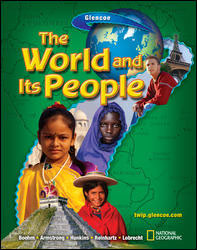
The World and Its PeopleChapter 5: CanadaChapter OverviewsCanada, the world's second-largest country in land area, is divided into ten provinces and three territories. The newest territory—Nunavut—was created in 1999 as a homeland for Canada's indigenous people, the Inuit. As a result of the glaciers that covered Canada thousands of years ago, Canada has more lakes and inland waterways than any other country in the world. Most of Canada has a cool or cold climate. Manufacturing, farming, and service industries are Canada's major economic activities. Like the United States, Canada has a strong free market economy. Fishing, mining, and lumbering are also important to the Canadian economy. In fact, Canada is the world's leading producer of newsprint. Native Americans and the Inuit were the first Canadians. French and British settlers later settled along the St. Lawrence River and near the Great Lakes. Canada was a colony of Great Britain until the Dominion of Canada was established in 1867. Canada's government is a parliamentary democracy, headed by a prime minister. Its culture reflects the country's diverse ethnic heritage. Canada is a bilingual country—its two official languages are French and English. Some people in French-speaking Quebec want independence from the rest of Canada. |  |















